Is Saké Beer ?

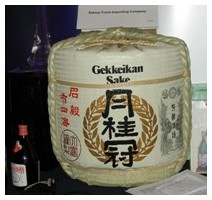 Is saké beer, or is saké a beverage unique unto itself? Many would argue that, since it is made from rice, (a grain), and fermented, it is truly beer. Others would say that the absence of hops for bittering and aroma, and the unusual use of fermentation agents (Koji, an enzyme, works in parallel conjunction with the saké yeast to raise the alcohol content between 17-20%) give it a distinctive quality that places sake in its own category of the world’s great beverages.
Is saké beer, or is saké a beverage unique unto itself? Many would argue that, since it is made from rice, (a grain), and fermented, it is truly beer. Others would say that the absence of hops for bittering and aroma, and the unusual use of fermentation agents (Koji, an enzyme, works in parallel conjunction with the saké yeast to raise the alcohol content between 17-20%) give it a distinctive quality that places sake in its own category of the world’s great beverages.
Saké is not “rice wine,” as it is sometimes mistakenly called. Wine is made from the single fermentation of fruit or vegetables, with the exception of those having a sparkling or champagne character. 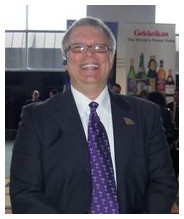 On 9 April 2008, I met the illustrious David Wagner of Event Navigators, Gladwyne, Pennsylvania, USA at the 4th Annual Saké Festival, held in conjunction with the Subaru Cherry Blossom Festival of Greater Philadelphia. He greeted me at the Millennium Ballroom in the Loews Philadelphia Hotel, where saké merged in seductive pairings with gourmet fare from the finest restaurants in Philadelphia. With high enthusiasm, Mr. Wagner spoke of dozens of saké products throughout the room, explaining the various sections and the styles not to be missed. I was there for an education on one of the great beverages of the world – one that was so pleasant that it deserves encore after encore.
On 9 April 2008, I met the illustrious David Wagner of Event Navigators, Gladwyne, Pennsylvania, USA at the 4th Annual Saké Festival, held in conjunction with the Subaru Cherry Blossom Festival of Greater Philadelphia. He greeted me at the Millennium Ballroom in the Loews Philadelphia Hotel, where saké merged in seductive pairings with gourmet fare from the finest restaurants in Philadelphia. With high enthusiasm, Mr. Wagner spoke of dozens of saké products throughout the room, explaining the various sections and the styles not to be missed. I was there for an education on one of the great beverages of the world – one that was so pleasant that it deserves encore after encore.
Anthropologists center the initial brewing of saké in China, with evidence of its beginnings to be approximately 3000 B.C. As trade and the Warrior Class expanded throughout Asia, saké was introduced into Japanese culture, where it was refined and improved throughout 5000 years. There are generally only nine types of rice used to make saké. These types of rice have a larger center core, or “white heart,” where starches are concentrated. The outer layers that contain the fats, amino acids and proteins are polished away to expose this delicate center. The more polished the grain is, the more delicate the flavors of saké. 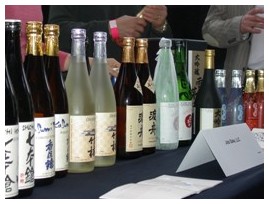 Some saké, particularly those that are unpasteurized, must be consumed “fresh.” However, most sake is aged for six months, but some have the ability to gracefully age for decades.
Some saké, particularly those that are unpasteurized, must be consumed “fresh.” However, most sake is aged for six months, but some have the ability to gracefully age for decades.
With more than 14,000 different sakes worldwide, it would be difficult to briefly list all the styles, varieties, and brewing methods that distinguish one from another. However, within the world of saké, broad terms categorize sake based on the amount of polish, brewing methods, filtering, and additives. Some of the more scopic categories are:
Doburoku – A classic homebrew style of saké that is lightly filtered, producing a cloudy, milky product. Steamed rice is added at the end of primary fermentation, stimulating a secondary fermentation and higher alcohol levels. This is similar to Nigorizake, but with a chunkier texture. It is unpasteurized.
Genshu – Saké in its purest form, with alcohol levels of 20-22%
Honjozo - Pure rice is polished 30-40%, then distilled alcohol is added, which separates extra flavors out of the mash
Infused – At the end of the brewing process, flavor is added to create distinctive qualities
Junmai – Pure rice is polished 30-40%
Junmai Ginjo - Pure rice is polished 40-50%
Junmai Daiginjo - Pure rice is polished more than 50%
Koshu – Specialty saké that can endure decades of aging. It takes on a yellow hue and flavors of honey
Kuroshu – Chinese style saké, made with unpolished rice
Namakazi – A term for “raw” saké that is unpasteurized and requires refrigeration
Nigorizake – Loosely filtered sake that is milky in color
Seishu – The official name for Japanese Sake; Nigorizake and Doburoku are not included in this category
Taruzake – Specialty saké that is aged in cedar barrels and takes on a distinctive spiciness as a result
How does sake taste?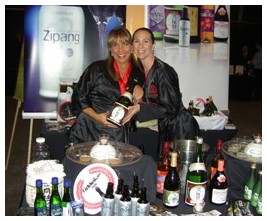 Sake can be sweet or dry, sparkling or still, intense, fruity, floral, acidic, or lively with layers of complexity. Sidney Frank was the first to import sake into the United States, and it is with humble gratitude that my taste-buds experienced the delights of another culture.
Sake can be sweet or dry, sparkling or still, intense, fruity, floral, acidic, or lively with layers of complexity. Sidney Frank was the first to import sake into the United States, and it is with humble gratitude that my taste-buds experienced the delights of another culture.
My tasting notes from the festival will shed some light on the diversity of sake:
Hou Hou Shu Sparkling Saké – Marumoto Brewery, Okayama, Japan – 6% ABV – Attractive blue bottle with silver foil at the neck; secondary fermentation in the bottle; fruity and sweet, with high levels of effervescence.
Hana Hou Hou Shu Sparkling Saké – Marumoto Brewery, Okayama, Japan – 6.1% ABV – Pretty Pink Bottle; saké is made with rose hips and hibiscus, and has a sweet floral profile with notes of citrus
Ban Ryu – Eiko Fuji Saké Brewery, Tsuruoka-City Yamagata – distilled flavor, dry, warming, alcoholic, touched with flavors of licorice
Kimoto Extra Dry – Kasumi Tsuru Company, Hyogo, Japan - 17.5% ABV – The crane of Kimoto, this sake has added spirits. Flavor coats the tongue and alcohol bitterness is felt in the back of the mouth
Shichi Hon Yari – Tomita Brewery, Shiga-Ken, Japan – 15-16% ABV – Junmai style, with a light, light mouthfeel; complex layers of grain, light florals, and bitterness.
Chikurin Karoyaka Junmai Ginjo Saké - Chikurin Karoyaka Junmai, Japan – 15-16% ABV – This brewery was founded in 1867, in Okayama, in the Chikurin Mountains. True “estate grown saké,” this Junmai Ginjo is very refined, with flavors of licorice, cherries, peaches, and apricots. It is best served chilled.
Yuki No Bosha - The Saiya Shuzouten, Ishiwaki Yurihonjo-city, Akita Prefecture, Japan – 17-18% - Daiginjo, “Cabin in the Snow,” from a brewery that “won eleven gold medals and three silvers at the Japanese National New Saké Competition in the fifteen years between 1990 and 2005.” This saké is highly polished, smooth and delicate. Really fine.
Umenoyado Sparkling Blueberry Saké – Umenoyado Shuzo Co., Ltd., Nara, Japan – 6.5% ABV – Pungent and fruity, best served with food. Triumph Brewing Company served a puff pastry with a touch of blueberry sauce and seared scallops, a triumph with this style of saké.
Crazy Milk Nigori Sake – Oimatsu Shuzo Co. Ltd, Hita, Oita, Japan – 15-16% ABV – Thick, white, milky and sweet, with a definite bite of bitterness to it; chunks of rice grains float throughout and deposit on the sides of the cup.
Tenranzan Junmai Ginjo Style Sake - Igarashi Syuzo Co., Ltd., Hanno-shi, Saitama-ken, Japan – 15-16% ABV – 45% rice is polished away, leaving a dry, slightly sweet, delicate flavor;star anise; clear and still, with alcoholic warmth.
Ishitsuchi Junmai Ginjo - Ishitsuchi Shuzo, Ehime Region, Japan – 17% ABV – 2007 Joy of Sake Gold Award in the USA; made with water, rice, rice Koji; very clear, medium dry, delicate sweetness, licorice, earthy.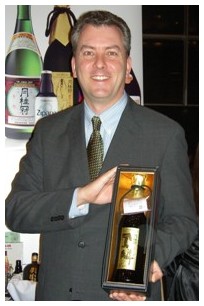 Tenmai Daiginjo Saké - Akebono Shuzo, Fukushima Prefecture, Japan – rare and wonderful, from an all female saké maker; fruity, sweet and medium bodied.
Tenmai Daiginjo Saké - Akebono Shuzo, Fukushima Prefecture, Japan – rare and wonderful, from an all female saké maker; fruity, sweet and medium bodied.
Choya Ume Blanc – Choya Umeshu Co, Ltd., Osaka, Japan – Organic Plum Wine, made entirely from plums, and not categorized as sake. Pronounced “wu-meh”, this is highly fruity and acidic.
Gekkeikan Black & Gold Junmai Ginjo Saké – Gekkeikan Saké, USA, Folsom, California, USA – 15.6% ABV - Sake is traditionally made in Tokori Pots, and this one is served from a black and gold bottle that is a miniature replica of the Tokori Pot; light and floral, with alcoholic warmth.
Gekkeikan Horin Ultra Premium Junmai Daiginjo - Gekkeikan Saké, USA, Folsom, California, USA – 50% polished rice; delicate; marketed as “what the emperor drinks,” although I preferred the Black & Gold to this one. Recommended drinking temperature is chilled or room temperature.
This is a small sampling of the diversity available at Philadelphia’s 4th Annual Saké Festival, one that titillated the senses enough to inspire thoughts of visiting toji, official crafters of saké, in their own terroir.
Cheers!
Photos are (from top): Sake Barrel; David Wagner of Event Navigators at the 4th Sake Festival in Philadelphia; Diversity of Sake; Gekkeikan Girls show off premium products; Marc Pitcher and Horin Premium Sake
You Should Also Read:
Beer Fox Personality Profiles for Beer Enthusiasts
Caribbean Island Guide to Beer
Happy Hour Bees , Mythology and Mead

Related Articles
Editor's Picks Articles
Top Ten Articles
Previous Features
Site Map
Content copyright © 2023 by Carolyn Smagalski. All rights reserved.
This content was written by Carolyn Smagalski. If you wish to use this content in any manner, you need written permission. Contact Carolyn Smagalski for details.



